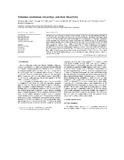Please use this identifier to cite or link to this item:
http://hdl.handle.net/10311/1029| Title: | Tylosema esculentum extractives and their bioactivity |
| Authors: | Mazimba, O. Majinda, R.R. Modibedi, C. Masesane, I.B. Cencicˇ, A. Chingwaru, W. |
| Keywords: | Tylosema esculentum Antioxidant Antimicrobial Cytotoxicity Fatty acids |
| Issue Date: | 2011 |
| Publisher: | Elsevier Science Ltd, http://www.elsevier.com/locate/bmc |
| Citation: | Mazimba, O. et al (2011) Tylosema esculentum extractives and their bioactivity, Bioorganic & Medicinal Chemistry, Vol. 19, No. 17, pp. 5225–5230 |
| Abstract: | The investigation of Tylosema esculentum (Morama) husks, cotyledons, and tuber yielded griffonilide 2, compound 1, griffonin 3, gallic acid 4, protocatechuic acid 5, b-sitosterol 6, behenic acid 7, oleic acid 8, sucrose 9, 2-O-ethyl-a-D-glucopyranoside 10, kaempferol 11 and kaempferol-3-O-b-D-glucopyranoside 12. The structures of the isolates were determined by NMR, HR-TOF EIMS, IR and UV–vis spectroscopy, and by comparison with literature data. The husk EtOAc and n-butanol extracts demonstrated >90% DPPH radical scavenging activity at concentrations of 25, 50 and 250 lg/mL. Furthermore the husk extracts showed higher total phenolic content (233 mg GAE/g). The extractives exhibited minimum inhibitory quantities of 50–100 lg or no activity against Staphylococcus aureus, Escherichia coli, Bacillus subtilis, Pseudomonas aeruginosa and Candida albicans. The tuber extracts were inactive against Caco-2 and Hela cell lines, while the husk extracts showed low activity against Caco-2 and Vero cell line with IC50 values >400 lg/mL. The GC–MS analysis showed the beans and tuber non-polar (n-hexane) extracts major constituents as fatty acids. |
| URI: | http://hdl.handle.net/10311/1029 |
| ISSN: | 0968-0896 |
| Appears in Collections: | Research articles (Dept of Chemistry) |
Files in This Item:
| File | Description | Size | Format | |
|---|---|---|---|---|
| Mazimba_BMC_2011.pdf | 682.44 kB | Adobe PDF |  View/Open |
Items in DSpace are protected by copyright, with all rights reserved, unless otherwise indicated.
